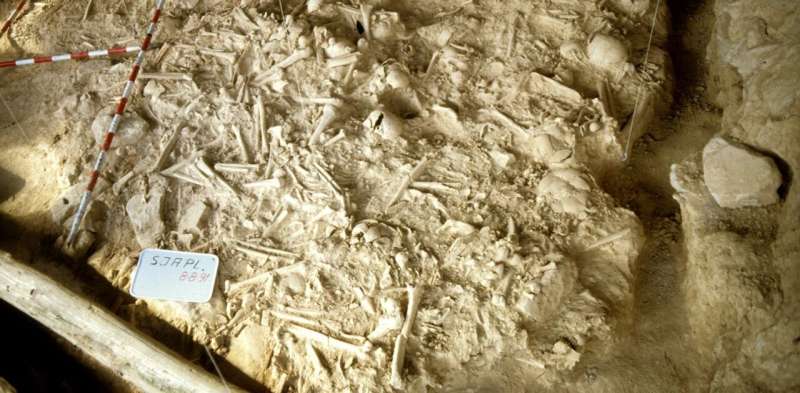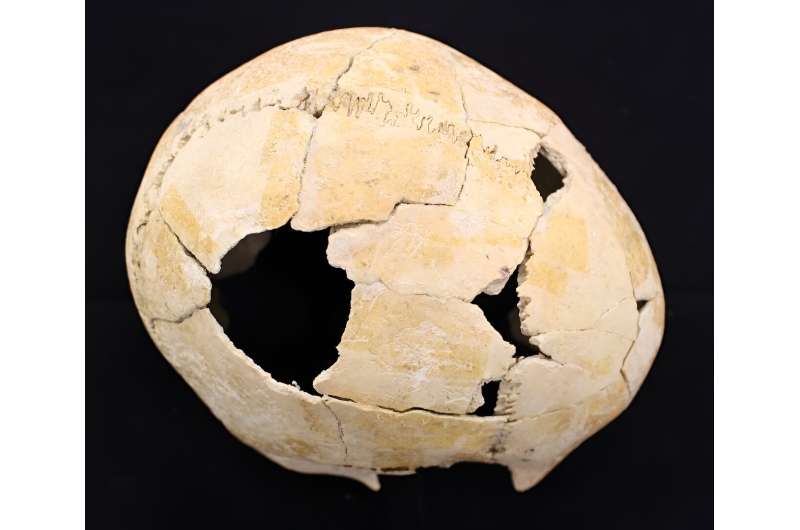This article has been reviewed according to Science X's editorial process and policies. Editors have highlighted the following attributes while ensuring the content's credibility:
fact-checked
trusted source
written by researcher(s)
proofread
War in Europe is more than 5,000 years old, researchers find

Conflict has existed throughout human history, and it has often been violent. Attacks, assassinations, raids, ambushes, and vendettas feature in archaeological records almost as far back as the origin of humankind itself. But not war.
War—as opposed to conflict—requires organization, be it temporary or permanent. This usually involves the creation of institutionalized armies belonging to at least one of the groups involved. War legitimizes violence, meaning one person can kill another without it being considered murder. War is also temporary by nature, usually lasting for a period of months or years.
Various studies suggest a connection between the birth of war and human settlement, when control of land and property became increasingly important.
The emergence of surpluses during the Neolithic era, especially in agriculture and livestock, soon led to concentrated power, permanent inequality, and the desire to expand and defend territories. It also led to the establishment of the first states, which maintained, expanded, and consolidated power by recruiting large armies to wage war as we understand it today.
The birth of war
To trace the emergence of warfare, prehistorians, and archaeologists have long been forced to rely on indirect indicators. These include defenses, recorded appearances of weapons, or the identification of certain graphic elements, such as cave paintings. More recently, research has shifted towards direct evidence, particularly wounds on human bones, which are arguably the most incontrovertible evidence we have of past violence.
Thanks to advances in forensic anthropology, we have learned that the vast majority of known mass burial sites with signs of violence in European prehistory until well into the Neolithic era (6000-3000 BC) were essentially massacred . These were indiscriminate killings of communities of no more than 20-30 people, including whole populations of men, women, and children, as a result of brutal surprise attacks by other groups.
The few archaeological sites that do not fit into this category appear to be the result of sacrifices or other violent ritual practices.
At sites such as the British settlements of Crickley Hill and Hambledon Hill, the discovery of hundreds of arrow heads around defenses might suggest large coordinated attacks, but there is little to no skeletal evidence that they had actually been used in battle. For this, one would have to wait until the Bronze Age, around 1200 BC and the Battle of Tollense in Germany.
San Juan ante Portam Latinam: Broken bones and paradigms
The burial site at San Juan ante Portam Latinam (SJAPL) was discovered in 1985 in Laguardia (Álava, Spain), and was excavated by J. I. Vegas and his collaborators 1990 and 1991. The skeletal remains of at least 338 people were found there, which were dated to around 3200 BC, in the late Neolithic period.

Initial studies found evidence of violence. Specifically, there were 53 head injuries and eight arrowhead wounds that had occurred sometime before death (antemortem) and had already healed. However, there were also five arrowhead wounds and one head injury that had occurred around the time of death (perimortem), and had not healed.
Furthermore, it was suspected that the 52 flint arrowheads found in isolation (most with signs of impact) had been stuck in the bodies buried there and had not been deliberately buried with them. Therefore, despite the apparently limited number of unhealed wounds, the burial site was originally thought to be the result of a massacre, possibly because of the lack of known prehistoric sites with signs of collective violence at the time.
Previous study on European Neolithic sites with evidence of violence soon made the uniqueness of SJAPL clear. While perimortem trauma, especially cranial trauma that is typical of melee combat, predominated at other sites, arrowhead wounds—evidence of combat at a distance—and antemortem trauma seemed to predominate at SJAPL. This suggested a longer, more complex, and less lethal conflict.
The demographic at the site is also different from others. While at other sites, there were men, women, and children, there were predominantly adolescent or adult males at SJAPL.
Reexamining the remains
Recently, we have reexamined the remains found at SJAPL to assess its singular, anomalous results. This review identified a total of 107 head injuries, of which 48 were unhealed and 59 healed, and a total of 47 injuries to other parts of the skeleton, of which 17 were unhealed and 30 healed.
Interestingly, the vast majority involved adolescent and adult males, particularly those who were unhealed. In addition, some of these men were found to have both healed and unhealed wounds, indicating that they had been exposed to violence on several occasions.
This review estimated that at least 23% of the people buried at SJAPL had suffered a violent event in their lifetime, and at least 10% had died as a result. However, this is a very low estimate, as it does not take into account the 52 arrowheads that may have impacted soft tissue or injured bones that cannot be linked to specific individuals. Including these factors would mean that an estimated 90 individuals (27%) died due to violence at SJAPL.
In addition, it is worth bearing in mind that only around 50% of wounds leave a mark on the bone and that the preservation of the remains at SJAPL is quite poor, with multiple recent postmortem fractures affecting the record. Therefore, the final number could easily be double or triple our estimates.
Based on these results, SJAPL is the oldest European site to date in which a large-scale, organized, and long-lasting conflict has been clearly documented. Furthermore, the area of Rioja Alavesa, where SJAPL is located, is the European region with the highest total number of arrowhead wounds (identified in at least three other sites), all of them from between 3380 and 3000 BC, indicating a regional conflict.
High rates of nutritional deficiency documented in SJAPL show a declining quality of life but also reveal the previously unsuspected logistical capacity of late neolithic communities to sustain violent conflict over time, i.e., to wage war. That makes it the first documented example of warfare on the continent in Neolithic times, almost two millennia earlier than previously assumed.
Provided by The Conversation
This article is republished from The Conversation under a Creative Commons license. Read the original article.![]()




















